hood open TOYOTA AVALON 2019 Owners Manual (in English)
[x] Cancel search | Manufacturer: TOYOTA, Model Year: 2019, Model line: AVALON, Model: TOYOTA AVALON 2019Pages: 536, PDF Size: 9.43 MB
Page 5 of 536

5
1
8 7 5 4
3
2
9
6
5-4. Other interior featuresOther interior features ....... 330
• Sun visors ..................... 330
• Vanity mirrors................ 330
• Power outlet .................. 331
• USB charging ports....... 332
• Wireless charger ........... 334
• Armrest ......................... 343
• Assist grips ................... 343
• Coat hooks.................... 344
Garage door opener .......... 345
Safety Connect.................. 352 6-1. Maintenance and care
Cleaning and protecting the vehicle exterior .......... 360
Cleaning and protecting the vehicle interior ........... 363
6-2. Maintenance Maintenance requirements ................... 366
General maintenance ........ 368
Emission inspection and maintenance (I/M)
programs ......................... 372
6-3. Do-it-yourself maintenance
Do-it-yourself service precautions ...................... 373
Hood .................................. 375
Positioning a floor jack....... 376
Engine compartment ......... 377
Tires................................... 387
Tire inflation pressure ........ 401
Wheels............................... 404
Air conditioning filter .......... 406
Electronic key battery ........ 408
Checking and replacing fuses ................................ 410
Light bulbs ......................... 4136Maintenance and care
Page 15 of 536
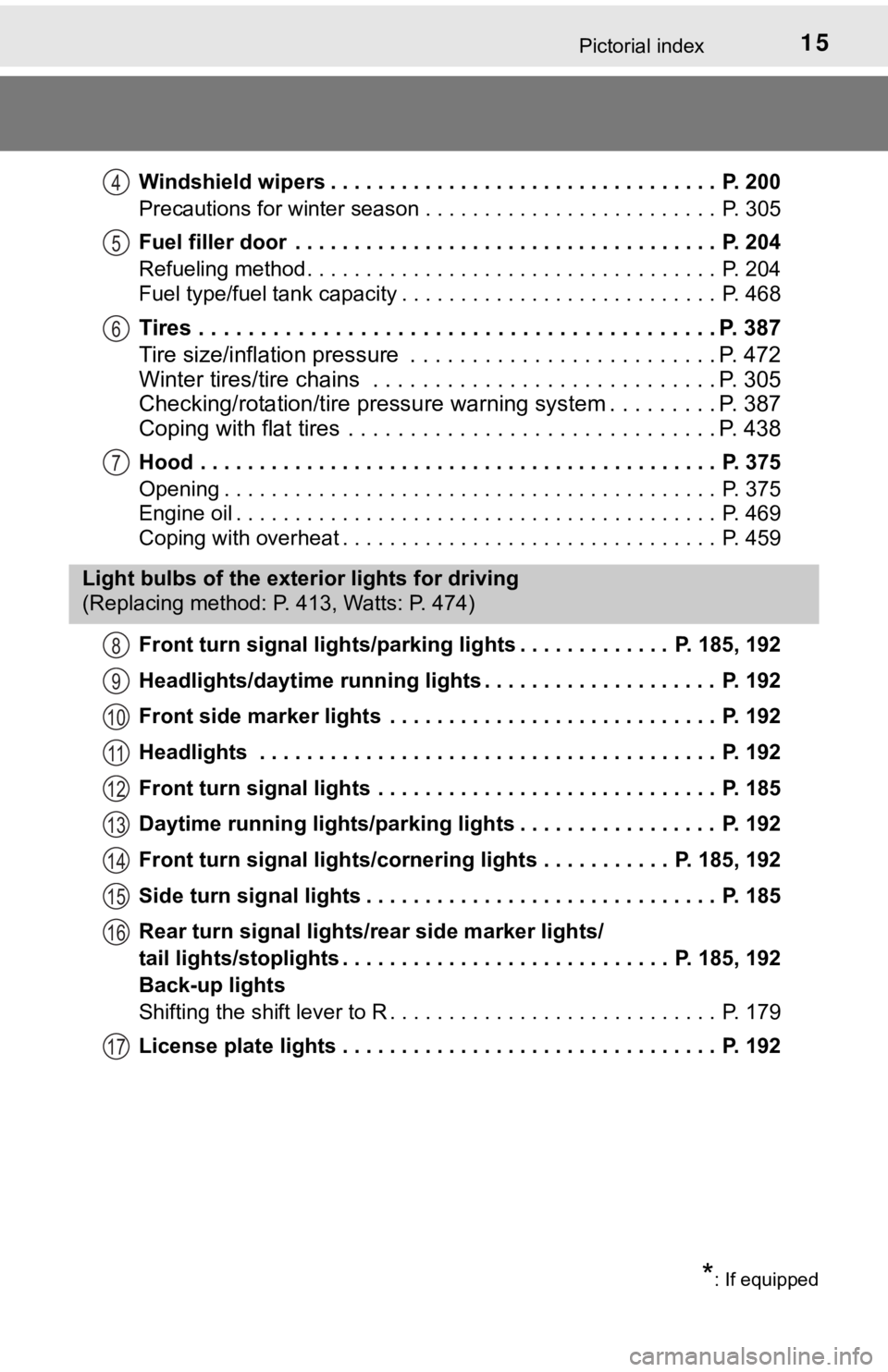
15Pictorial index
Windshield wipers . . . . . . . . . . . . . . . . . . . . . . . . . . . . . . . . . P. 200
Precautions for winter season . . . . . . . . . . . . . . . . . . . . . . . . . P. 305
Fuel filler door . . . . . . . . . . . . . . . . . . . . . . . . . . . . . . . . . . . . P. 204
Refueling method . . . . . . . . . . . . . . . . . . . . . . . . . . . . . . . . . . . P. 204
Fuel type/fuel tank capacity . . . . . . . . . . . . . . . . . . . . . . . . . . . P. 468
Tires . . . . . . . . . . . . . . . . . . . . . . . . . . . . . . . . . . . . . . . . . . P. 387
Tire size/inflation pressure . . . . . . . . . . . . . . . . . . . . . . . . . P. 472
Winter tires/tire chains . . . . . . . . . . . . . . . . . . . . . . . . . . . . P. 305
Checking/rotation/tire pressur e warning system . . . . . . . . .P. 387
Coping with flat tires . . . . . . . . . . . . . . . . . . . . . . . . . . . . . . P. 438
Hood . . . . . . . . . . . . . . . . . . . . . . . . . . . . . . . . . . . . . . . . . . . . P. 375
Opening . . . . . . . . . . . . . . . . . . . . . . . . . . . . . . . . . . . . . . . . . . P. 375
Engine oil . . . . . . . . . . . . . . . . . . . . . . . . . . . . . . . . . . . . . . . . . P. 469
Coping with overheat . . . . . . . . . . . . . . . . . . . . . . . . . . . . . . . . P. 459
Front turn signal lights/parking lights . . . . . . . . . . . . . P. 185, 192
Headlights/daytime running lights . . . . . . . . . . . . . . . . . . . . P. 192
Front side marker lights . . . . . . . . . . . . . . . . . . . . . . . . . . . . P. 192
Headlights . . . . . . . . . . . . . . . . . . . . . . . . . . . . . . . . . . . . . . . P. 192
Front turn signal lights . . . . . . . . . . . . . . . . . . . . . . . . . . . . . P. 185
Daytime running lights/parking lights . . . . . . . . . . . . . . . . . P. 192
Front turn signal lights/cornering lights . . . . . . . . . . . P. 185, 192
Side turn signal lights . . . . . . . . . . . . . . . . . . . . . . . . . . . . . . P. 185
Rear turn signal lights/r ear side marker lights/
tail lights/stoplights . . . . . . . . . . . . . . . . . . . . . . . . . . . . P. 185, 192
Back-up lights
Shifting the shift lever to R . . . . . . . . . . . . . . . . . . . . . . . . . . . . P. 179
License plate lights . . . . . . . . . . . . . . . . . . . . . . . . . . . . . . . . P. 192
4
5
6
7
Light bulbs of the exter ior lights for driving
(Replacing method: P. 413, Watts: P. 474)
*: If equipped
8
9
10
11
12
13
14
15
16
17
Page 53 of 536
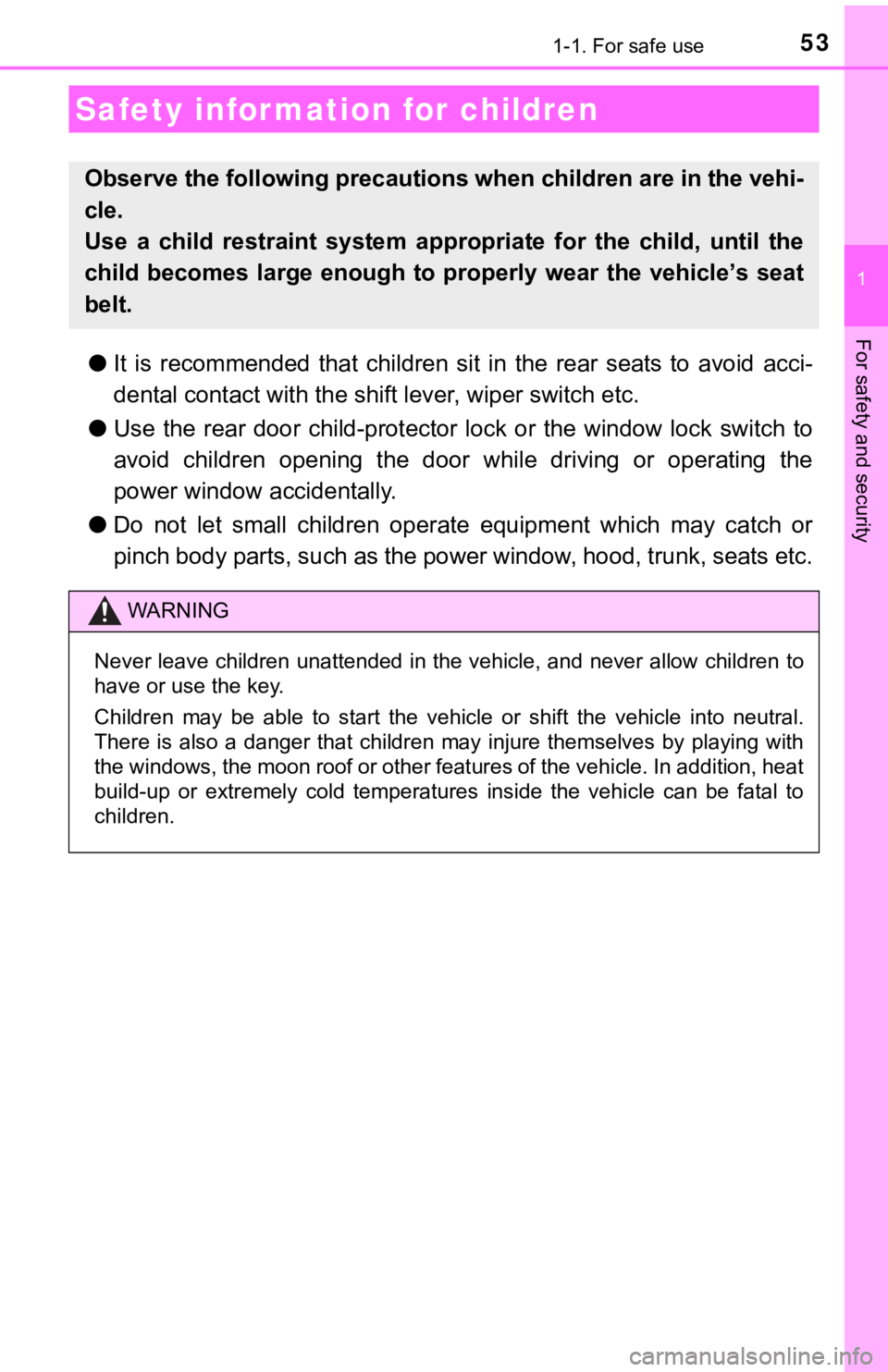
531-1. For safe use
1
For safety and security
●It is recommended that children sit in the rear seats to avoid acci-
dental contact wit h the shift lever, wiper switch etc.
● Use the rear door child-protector lock or the window lock switc h to
avoid children opening the door while driving or operating the
power window accidentally.
● Do not let small children operate equipment which may catch or
pinch body parts, such as the power window, hood, trunk, seats etc.
Safety information for children
Observe the following precautions when children are in the vehi -
cle.
Use a child restraint system app ropriate for the child, until the
child becomes large enough to properly wear the vehicle’s seat
belt.
WARNING
Never leave children unattended in the vehicle, and never allow children to
have or use the key.
Children may be able to start the vehicle or shift the vehicle into neutral.
There is also a danger that children may injure themselves by p laying with
the windows, the moon roof or other features of the vehicle. In addition, heat
build-up or extremely cold temperatures inside the vehicle can be fatal to
children.
Page 72 of 536
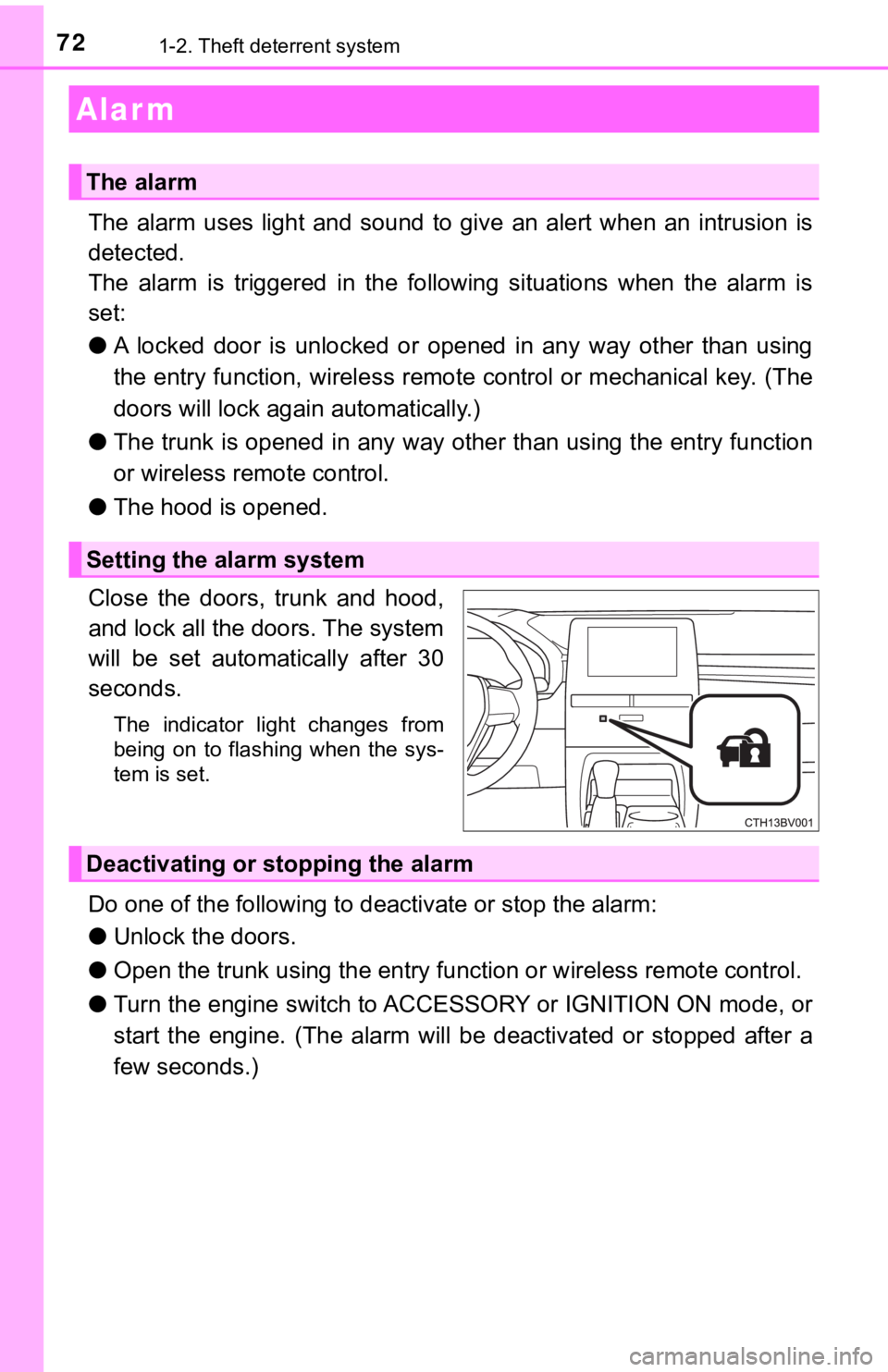
721-2. Theft deterrent system
The alarm uses light and sound to give an alert when an intrusion is
detected.
The alarm is triggered in the following situations when the ala rm is
set:
● A locked door is unlocked or opened in any way other than using
the entry function, wireless remote control or mechanical key. (The
doors will lock aga in automatically.)
● The trunk is opened in any way other than using the entry funct ion
or wireless remote control.
● The hood is opened.
Close the doors, trunk and hood,
and lock all the doors. The system
will be set automatically after 30
seconds.
The indicator light changes from
being on to flashing when the sys-
tem is set.
Do one of the following to d eactivate or stop the alarm:
● Unlock the doors.
● Open the trunk using the entry function or w ireless remote control.
● Turn the engine switch to ACCESSORY or IGNITION ON mode, or
start the engine. (The alarm will be deactivated or stopped after a
few seconds.)
Alar m
The alarm
Setting the alarm system
Deactivating or stopping the alarm
Page 73 of 536
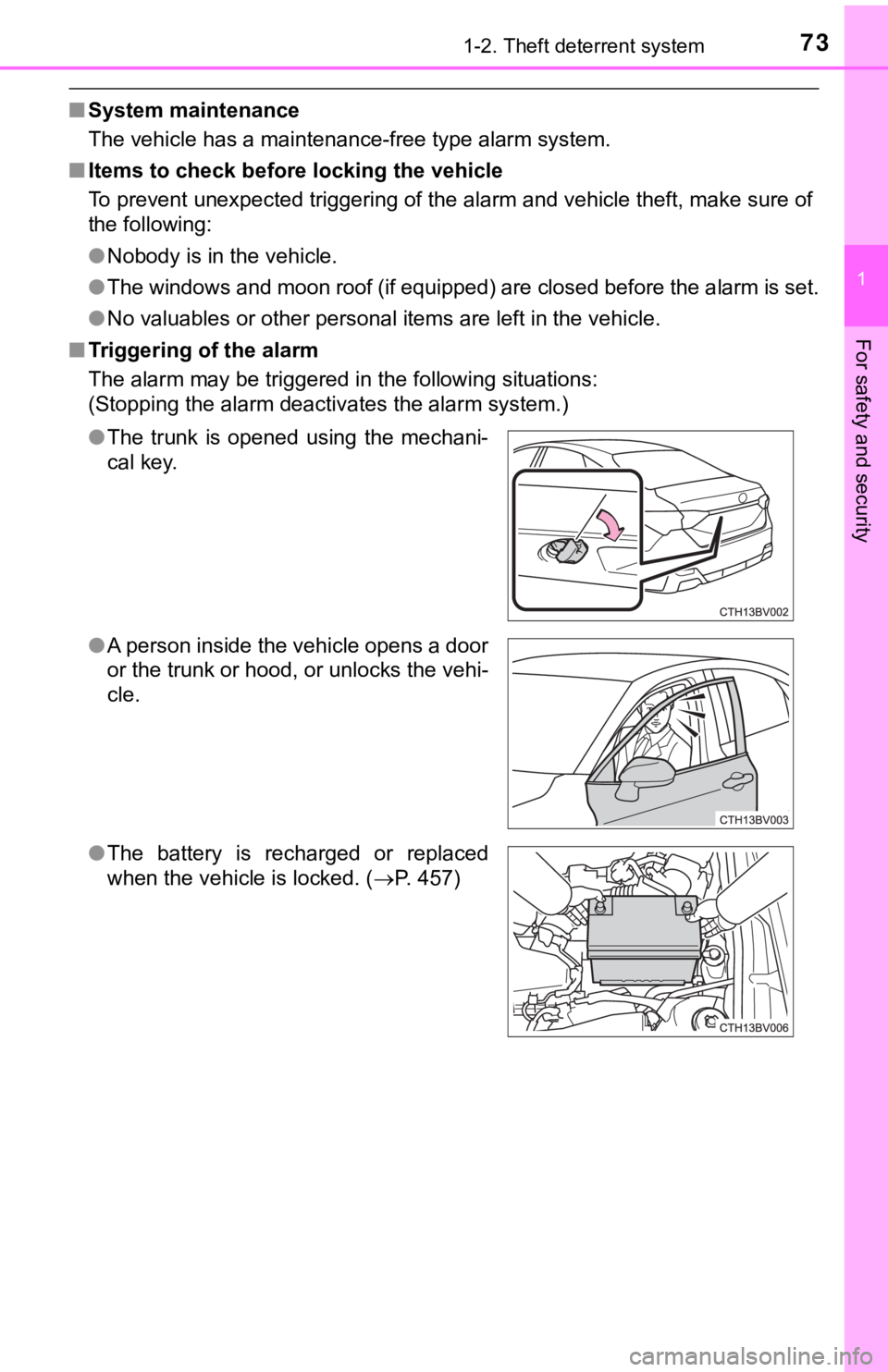
731-2. Theft deterrent system
1
For safety and security
■System maintenance
The vehicle has a maintenance-free type alarm system.
■ Items to check before locking the vehicle
To prevent unexpected triggering of the alarm and vehicle theft , make sure of
the following:
● Nobody is in the vehicle.
● The windows and moon roof (if equipped) are closed before the a larm is set.
● No valuables or other personal items are left in the vehicle.
■ Triggering of the alarm
The alarm may be triggered in the following situations:
(Stopping the alarm deactivates the alarm system.)
●The trunk is opened using the mechani-
cal key.
● A person inside the vehicle opens a door
or the trunk or hood, or unlocks the vehi-
cle.
● The battery is recharged or replaced
when the vehicle is locked. ( P. 457)
Page 226 of 536

2264-5. Using the driving support systems
●Some pedestrians such as the following may not be detected by t he radar
sensor and camera sensor, preventing the system from operating properly:
• Pedestrians shorter than approximately 3.2 ft. (1 m) or taller than approx-
imately 6.5 ft. (2 m)
• Pedestrians wearing oversized clothing (a rain coat, long skir t, etc.), mak-
ing their silhouette obscure
• Pedestrians who are carrying large baggage, holding an umbrell a, etc.,
hiding part of their body
• Pedestrians who are bending forward or squatting
• Pedestrians who are pushing a stroller, wheelchair, bicycle or other vehi-
cle
• Groups of pedestrians which are close together
• Pedestrians who are wearing white and look extremely bright
• Pedestrians in the dark, such as at night or while in a tunnel
• Pedestrians whose clothing appears to be nearly the same color or
brightness as their surroundings
• Pedestrians near walls, fences, guardrails, or large objects
• Pedestrians who are on a metal object (manhole cover, steel plate, etc.) on the road
• Pedestrians who are walking fast
• Pedestrians who are changing speed abruptly
• Pedestrians running out from beh ind a vehicle or a large object
• Pedestrians who are extremely close to the side of the vehicle (outside
rear view mirror, etc.)
■ If the PCS warning light flashes or illuminates and a warning m essage is
displayed on the multi-information display
The pre-collision system may be temporarily unavailable or there may be a
malfunction in the system.
● In the following situations, the warning light will turn off, t he message will
disappear and the system will become operational when normal op erating
conditions return:
• When the radar sensor or camera sensor or the area around eith er sen-
sor is hot, such as in the sun
• When the radar sensor or camera sensor or the area around eith er sen-
sor is cold, such as in an extremely cold environment
• When a front sensor is dirty or covered with snow, etc.
• When the part of the windshield in front of the camera sensor is fogged
up or covered with condensation or ice
(Defogging the windshield:
P. 312)
• If the camera sensor is obstructed, such as when the hood is open or a sticker is attached to the windshield near the camera sensor
● If the PCS warning light continues to flash or remains illuminated or the
warning message does not disappear even though the vehicle has returned
to normal, the system may be malfunctioning. Have the vehicle inspected by
your Toyota dealer immediately.
Page 375 of 536
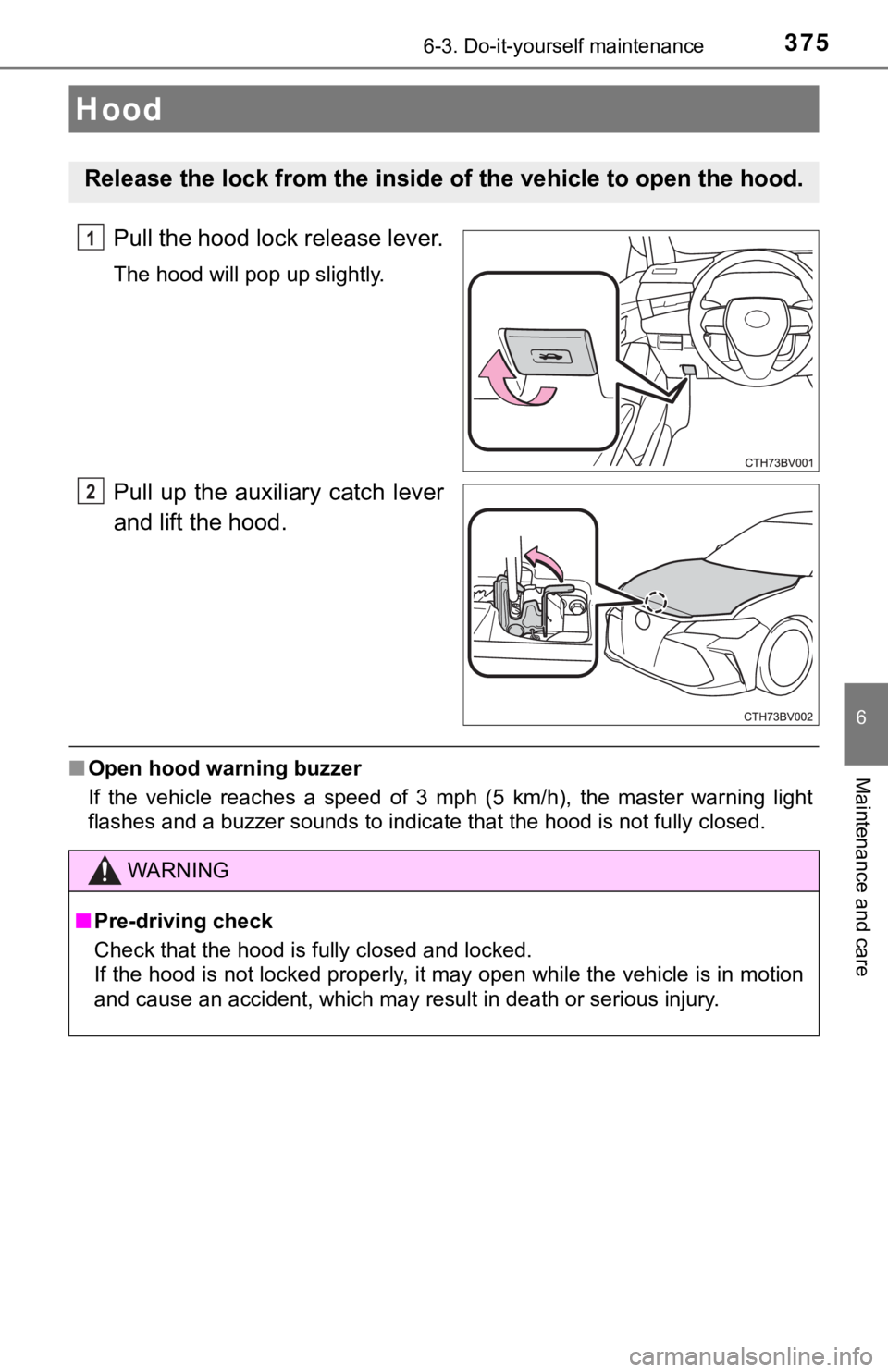
3756-3. Do-it-yourself maintenance
6
Maintenance and care
Pull the hood lock release lever.
The hood will pop up slightly.
Pull up the auxiliary catch lever
and lift the hood.
■Open hood warning buzzer
If the vehicle reaches a speed of 3 mph (5 km/h), the master warning light
flashes and a buzzer sounds to indicate that the hood is not fu lly closed.
Hood
Release the lock from the inside of the vehicle to open the hoo d.
1
2
WARNING
■Pre-driving check
Check that the hood is fully closed and locked.
If the hood is not locked properly, it may open while the vehic le is in motion
and cause an accident, which may result in death or serious inj ury.
Page 455 of 536
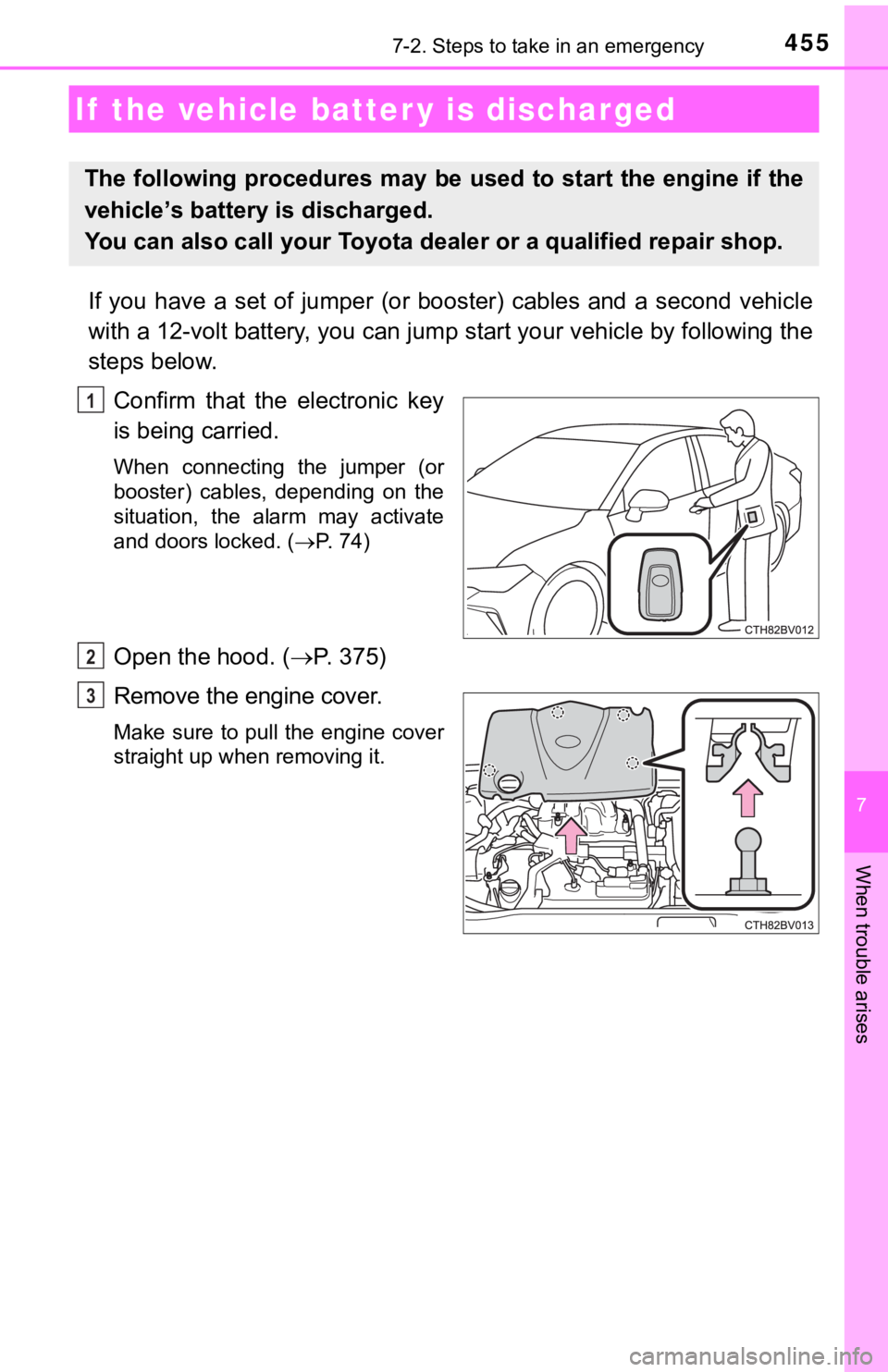
4557-2. Steps to take in an emergency
7
When trouble arises
If you have a set of jumper (or booster) cables and a second vehicle
with a 12-volt battery, you can jump start your vehicle by foll owing the
steps below.
Confirm that the electronic key
is being carried.
When connecting the jumper (or
booster) cables, depending on the
situation, the alarm may activate
and doors locked. ( P. 74)
Open the hood. ( P. 375)
Remove the engine cover.
Make sure to pull the engine cover
straight up when removing it.
If the vehicle batt er y is discharged
The following procedures may be used to start the engine if the
vehicle’s battery is discharged.
You can also call your Toyota de aler or a qualified repair shop.
1
2
3
Page 461 of 536
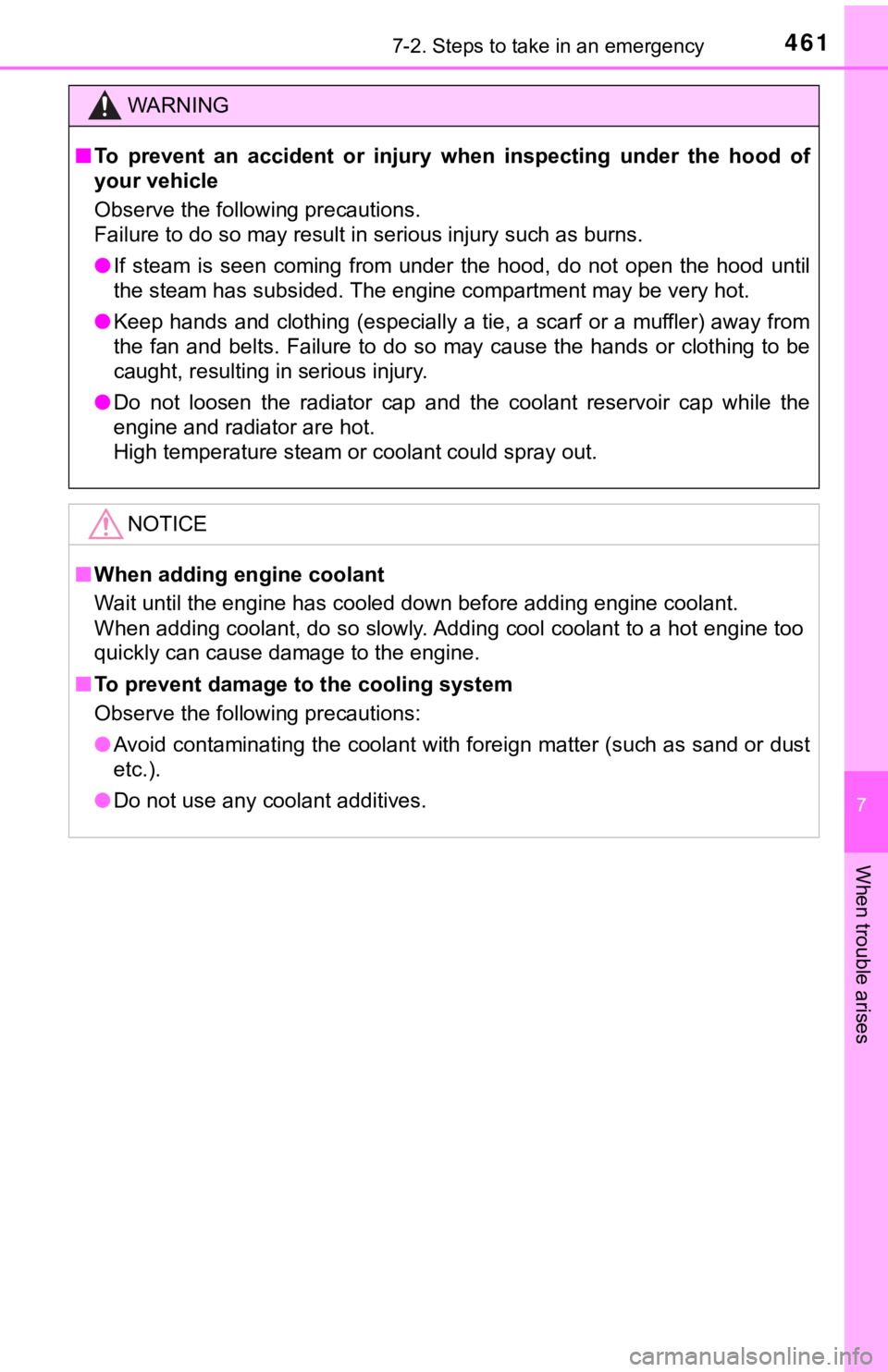
4617-2. Steps to take in an emergency
7
When trouble arises
WARNING
■To prevent an accident or injury when inspecting under the hood of
your vehicle
Observe the following precautions.
Failure to do so may result in serious injury such as burns.
● If steam is seen coming from under the hood, do not open the ho od until
the steam has subsided. The engine compartment may be very hot.
● Keep hands and clothing (especially a tie, a scarf or a muffler ) away from
the fan and belts. Failure to do so may cause the hands or clot hing to be
caught, resulting in serious injury.
● Do not loosen the radiator cap and the coolant reservoir cap wh ile the
engine and radiator are hot.
High temperature steam or coolant could spray out.
NOTICE
■ When adding engine coolant
Wait until the engine has cooled down before adding engine cool ant.
When adding coolant, do so slowly. Adding cool coolant to a hot engine too
quickly can cause damage to the engine.
■ To prevent damage to the cooling system
Observe the following precautions:
● Avoid contaminating the coolant with foreign matter (such as sa nd or dust
etc.).
● Do not use any coolant additives.
Page 525 of 536

525Alphabetical index
Front turn signal lightsReplacing light bulbs............. 413
Turn signal lever ................... 185
Fuel Capacity ................................ 468
Fuel gauge .............................. 82
Fuel pump shut off system.... 422
Information ............................ 475
Refueling............................... 204
Type .............................. 468, 475
Warning light ......................... 426
Fuel consumption.................... 107
Fuel filler door.......................... 204 If the fuel filler door cannot be opened............... 207
Refueling............................... 204
Fuel pump shut off system ..... 422
Fuses ........................................ 410
Garage door opener ................ 345
Gauges ....................................... 82
Glove box ................................. 324
Grocery bag hooks .................. 329 Head restraints ........................ 141
Head-up display....................... 100
Headlights ................................ 192
Automatic High Beam ........... 196
Light switch ........................... 192
Replacing light bulbs ............ 413
Windshield wiper linked
headlight illumination.......... 195
Heated steering wheel ............ 317
Heaters Automatic air conditioning system............ 310
Outside rear view mirrors ..... 312
Seat heaters ......................... 317
High mounted stoplight Replacing.............................. 413
Hill-start assist control ........... 299
Hood ......................................... 375
Hooks Coat hooks ........................... 344
Grocery bag hooks ............... 329
Retaining hooks (floor mat) .... 24
Horn .......................................... 144
HUD (Head-up display) ........... 100
G
H